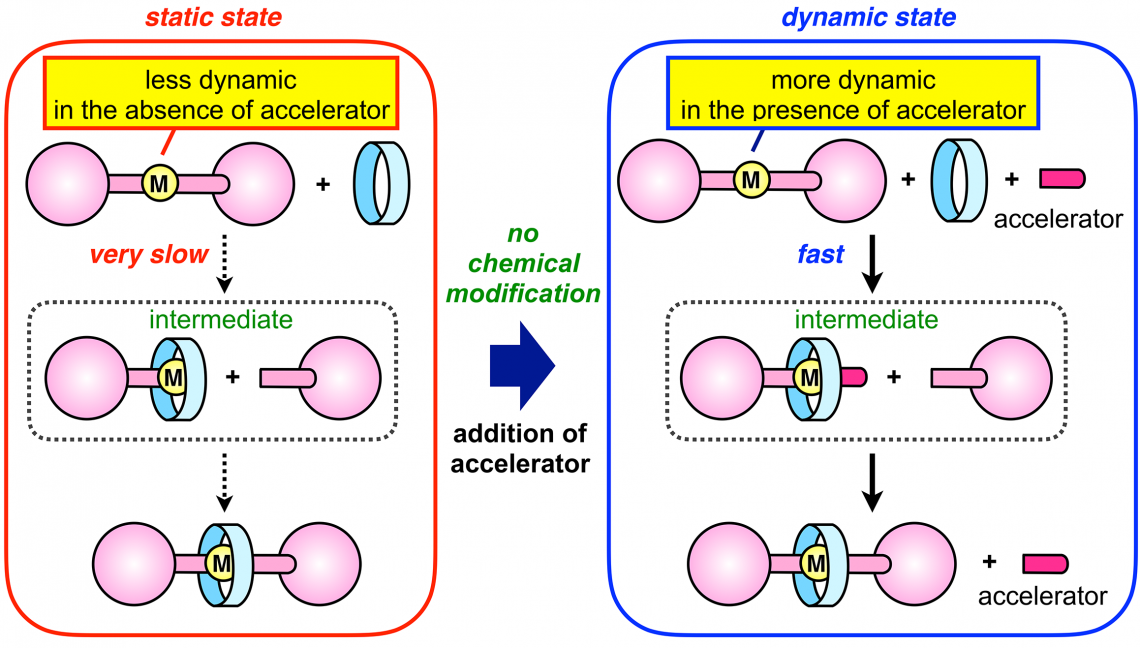Rotaxanes are molecules with a two-component structure: a dumbbell-shaped part (the ‘axle’) threaded through a ring-like part (the ‘wheel’). The two components are normally not chemically bound but mechanically interlocked. Rotaxanes are of particular interest because of their potential as building blocks for molecular machines, exploiting the rotation of the wheel or its motion along the axle. An extra level of rotaxane functionality is achieved if the wheel can be removed from the axle (dissociation) and put back (formation) in a controlled way. Shigehisa Akine, Yoko Sakata, and colleagues from Kanazawa University have now developed a new approach for controlled rotaxane dissociation and formation.
Earlier methods for the formation and dissociation of rotaxanes involved chemical modifications. One approach is to chemically replace one end (also called stopper) of the axle by a less bulky one so that the wheel can slide over it more easily. Another is to enlarge the wheel size. These two modifications result in ‘pseudorotaxanes’, however: rotaxanes for which the wheel can easily slide off the structure since at least one stopper doesn’t block the wheel anymore.
Akine, Sakata, and colleagues performed experiments with a proper rotaxane. At the center of the dumbbell is a palladium atom. At opposite sides to it, two identical organic groups (called 2,3-diaminotriptycene) are bound. For the wheel, they used a so-called crown ether, consisting of 9 oxygen atoms and 18 carbon atoms arranged in a symmetric, cyclic way.
The palladium rotaxanes did not form immediately when mixing axle and wheel parts. Nuclear magnetic resonance measurements showed that only after 10 hours, conversion to the rotaxane structure — confirmed by X-ray analysis — was complete. The researchers found that the rotaxane formation involves a temporary cleavage of the axle part: one 2,3-diaminotriptycene group disconnects from the palladium atom, the crown ether wheel then slides onto the part with the palladium atom, after which the ‘loose’ 2,3-diaminotriptycene group connects back. A similar cleavage process, with the wheel leaving the structure, results in dissociation.
Akine, Sakata, and colleagues then looked for a way to speed up the processes. They discovered that halide ions, and in particular bromine ions, had an accelerating effect on both formation and dissociation. The former was accelerated 27 times with the right amount of bromine ions added, and the latter 52 times. To achieve dissociation, though, the scientists had to add cesium ions to the mixture. A cesium ion easily forms a complex with a crown ether wheel; the cesium ion sits in the center of the wheel and prevents it from sliding back onto an axle molecule.
The use of accelerators as shown for this particular palladium-containing rotaxane is expected to be applicable to other molecules too. The scientists conclude that this strategy can be applied to the speed tuning of the formation/dissociation of various types of interlocked molecules based on metal coordination bonds.
Background
Rotaxanes
A rotaxane is a mechanically interlocked molecular structure consisting of a dumbbell-shaped molecule (axle) threaded through a circular molecule (wheel). The two components are locked because the ends of the dumbbell (called stoppers) are bigger than the internal diameter of the wheel, which prevents unthreading (dissociation) of the components. (A significant amount of distortion would be required to achieve unthreading.)
Most of the interest in rotaxanes and other mechanically interlocked molecular architectures lies in their potential as building blocks for molecular machines — nanoscale components that produce mechanical motion in response to particular external stimuli. Rotaxanes can act as molecular shuttles, for example: the wheel can be made to slide between the stoppers, from one side to the other, by stimuli such as light, solvents or ions.
Shigehisa Akine, Yoko Sakata, and colleagues from Kanazawa University have now studied the formation and dissociation process of a palladium-containing rotaxane. They discovered an intermediate cleavage phase in the formation/dissociation process and found that both the formation and the dissociation process can be significantly sped up by introducing accelerators, such as bromine ions.
Reference
[Authors] Yoko Sakata, Ryosuke Nakamura, Toshihiro Hibi, and Shigehisa Akine.
[Title] Speed Tuning of the Formation/Dissociation of a Metallorotaxane
[Journal] Angewandte Chemie International Edition
DOI: 10.1002/anie.202217048
https://onlinelibrary.wiley.com/doi/10.1002/anie.202217048
[Funded]
JSPS KAKENHI, The Iwata-ni Naoji Foundation, The Asahi Glass Foundation, Tobe Maki Scholarship Foundation, The Sumitomo Foundation, World Premier International Research Center Initiative (WPI), MEXT, Japan
Figure 1.
The use of an accelerator speeds up the formation process of the rotaxane.



